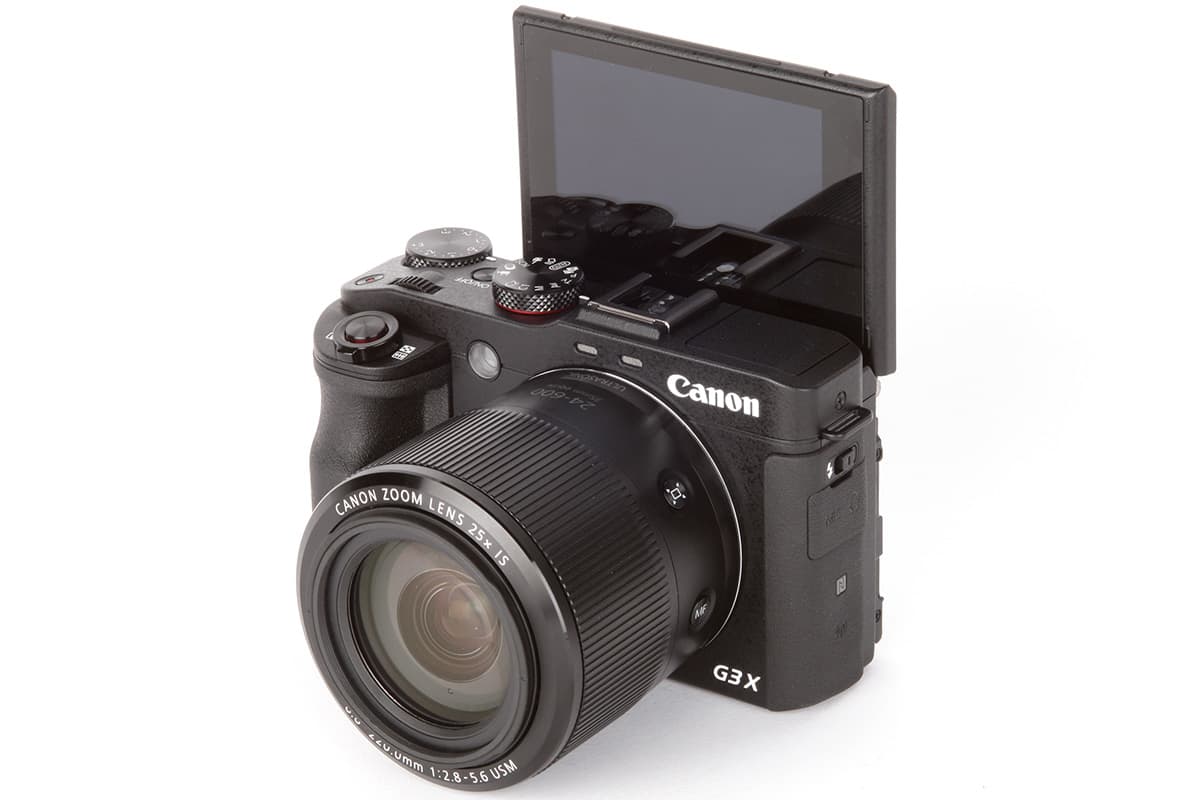Canon PowerShot G3 X review – Introduction

The G3 X’s lens covers a huge 25x zoom range from 24mm equiv (left) to 600mm (right)
At a glance:
- 20.2-million-pixel, 1in BSI CMOS sensor
- 24-600mm equivalent f/2.8-5.6 lens
- ISO 125-12,800
- 1.62-million-dot tilting touchscreen
- Dustproof and splashproof construction
- 5.9fps continuous shooting
- £800
One of the most welcome trends in camera design recently has been the adoption of relatively large sensors in fixed-lens compacts. In particular, the runaway success of Sony’s Cyber-shot DSC-RX100 series showed that there’s a real appetite for small cameras with much higher image quality than was achievable from small 1/2.3in or 1/1.8in sensors.
Canon was a relatively early player in this game, but its relatively bulky PowerShot G1 X series never quite captured photographers’ imaginations. Last year’s PowerShot G7 X was a rather more successful design, adopting much the same pocket-camera template as the RX100s. Now, with the PowerShot G3 X, Canon is going after a different market, combining a large sensor with a 25-600mm equivalent long zoom lens.

The Canon G3 X’s lens extends considerably when zoomed to the 600mm equivalent position
However, this isn’t uncharted territory, as the Sony Cyber-shot DSC-RX10 and Panasonic Lumix DMC-FZ1000 do something similar. Both feature relatively long zooms and electronic viewfinders in DSLR-like body designs. But Canon’s approach has two crucial differences – it has a longer zoom lens with a slower maximum aperture, and it sacrifices the built-in viewfinder, apparently to keep the camera as small as possible.
With manufacturers such as Sony and Panasonic currently making a point of adding electronic viewfinders to cameras wherever possible, the lack of a viewfinder on the G3 X is a perplexing design decision, and one that I’ve found myself cursing throughout my time with the camera. More on that later, but first let’s take a closer look at what the G3 X has to offer.
See our Canon PowerShot G3 X sample image gallery
Canon PowerShot G3 X – Features
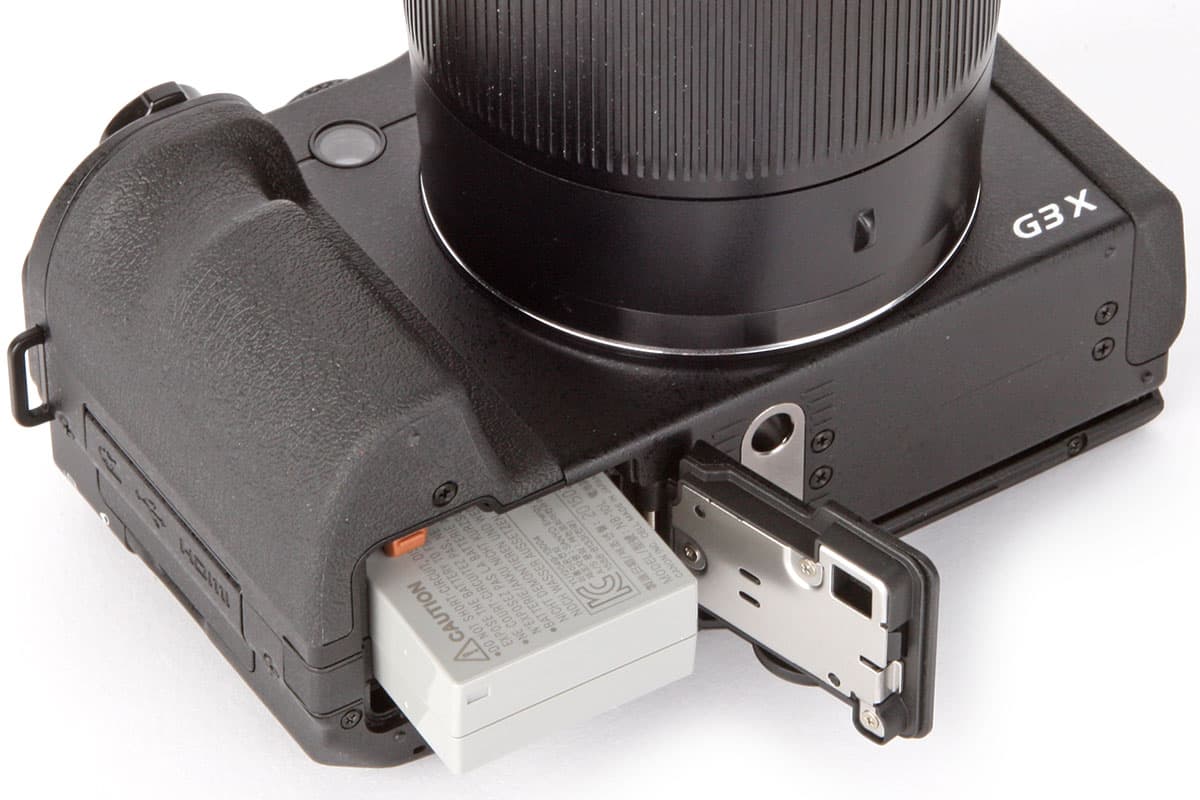
The NB-10L Li-ion battery is good for 300 shots per charge, by CIPA standard tests
To capture images, the G3 X uses a 20.2MP, 1in BSI CMOS sensor, which is likely the same Sony unit as that used in cameras like the Panasonic FZ1000, Sony RX10 and Canon’s own G7 X. Like most of those cameras, the sensitivity range covers ISO 125-12,800. Shutter speeds run from 30secs-1/2000sec, which isn’t especially fast by modern standards, and continuous shooting is available at 5.9 frames per second, although this drops to 3.2fps if you want the camera to refocus between shots.
However, there’s no doubting the G3 X’s headline feature – its 24-600mm equivalent optically stabilised zoom lens covers a vast wideangle to ultra-telephoto range, making it suitable for a huge array of subjects from landscapes to wildlife. The minimum focus distance is a mere 5cm from the front of the lens at wideangle, extending to 85cm at full telephoto, so it’s quite handy for close-ups too. But while the maximum aperture starts at f/2.8 at wideangle, it drops off pretty quickly, to f/4 at 50mm equivalent, f/5 at 85mm equivalent and f/5.6 all the way from 200mm equivalent through to its full telephoto setting. Canon has limited the minimum aperture to f/11 throughout, which is perfectly sensible to avoid excessive diffraction softening on this sensor format.
Additional exposure control is provided by a built-in 3-stop neutral density filter, which allows shooting wide open in bright sunlight. This is fortunate, as the lens doesn’t have a filter thread itself, although it’s possible to use 67mm-threaded attachments via the optional FA-DC67B filter adapter. This costs £40 in a kit with the LH-DC100 hood.

The built-in flash pops up from the top-plate, released by a sliding switch on the camera’s side
A small built-in flash pops up from the top of the camera, which is released by a sliding switch on the side. Canon specifies an optimistic-sounding 6.8m range at wideangle and 3.1m at telephoto, but this likely assumes use of a high ISO setting. For more creative lighting, a hotshoe accepts Canon’s EX-series flashguns and third-party Canon-dedicated units, but sadly the internal flash can’t be used to control external units wirelessly.
Canon describes the G3 X as a ‘stills and video powerhouse’, and to this end it can record full HD 1,920×1,800-pixel movies at a full range of frame rates comrpsing 60, 50, 30, 25 and 24fps. Sound is recorded by a built-in stereo microphone, and the camera has a pair of 3.5mm stereo sockets for an external microphone and, more unusually, headphones. There’s a configurable peaking display to aid manual focus, but no overexposure warning. This counts as a quite respectable video specification, but it is easily trumped by the 4K-capable FZ1000 and Sony’s new but expensive RX10 II.
As we’d expect, the camera has built-in Wi-Fi, and as usual for Canon it has a wider range of applications than most. Images can be transferred between cameras, copied to a computer or output to a Wi-Fi-enabled printer. Naturally, the camera can also connect to a smartphone or tablet, with built-in NFC for easy pairing to a compatible device. Canon’s new Camera Connect app for iOS and Android allows both image sharing and remote operation of the camera, with plenty of manual control. A small button behind the mode dial activates Wi-Fi for connection to your smartphone or tablet.
Canon PowerShot G3 X review – Screen and viewfinder
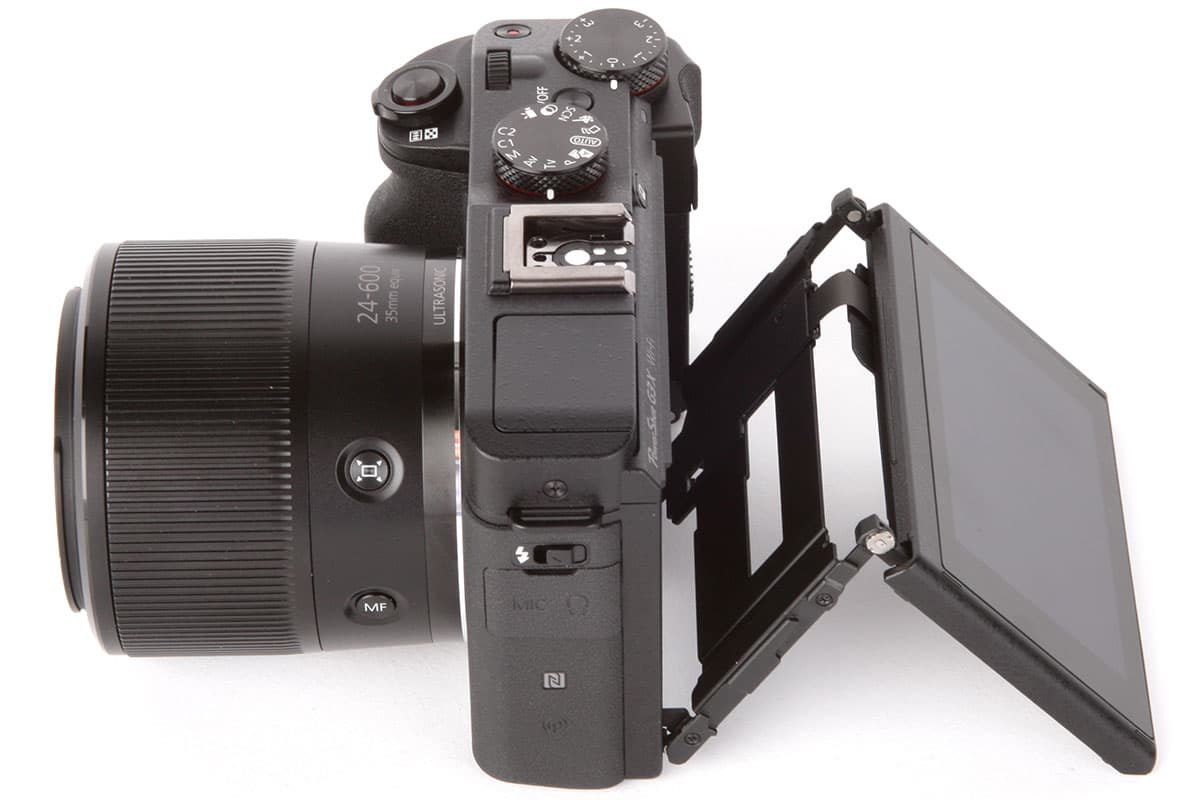
The touchscreen tilts 45° downwards, and 180° upwards to face forwards for selfies
The rear of the G3 X is dominated by its 3.2in screen, which at 1.62 million dots is of an unusually high resolution. It is bright and detailed, but gives a somewhat over-exaggerated rendition of the G3 X’s already-strong colours, with bright reds looking particularly cartoonish.
The screen titlts both 45° downwards and 180° upwards, to face fully forwards for selfies, but the complex mechanism required for this results in an unusually large bezel around the LCD. Personally, I’d have preferred a fully articulating screen, which would work better for portrait-format shooting.
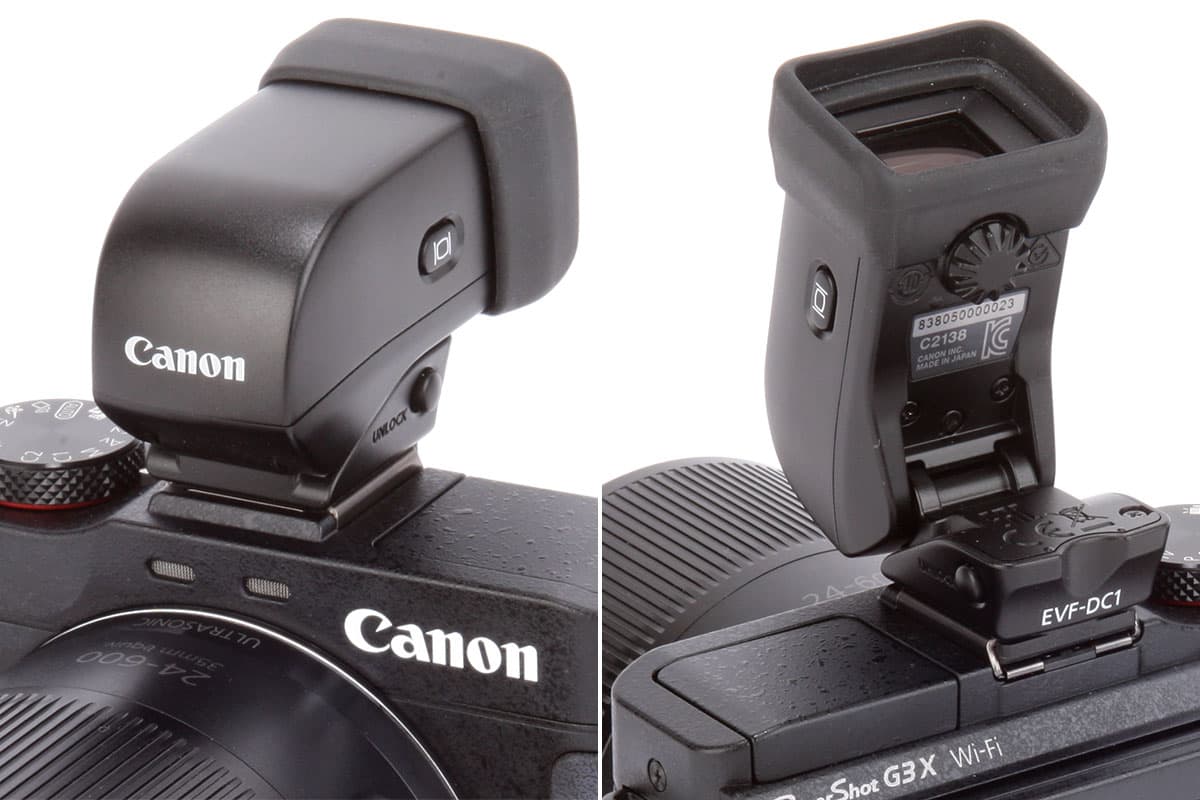
The optional £200 EVF-DC1 fits onto the hotshoe and tilts upwards 90°. It transforms the camera’s handling when shooting at telephoto
There’s no built-in viewfinder, but thankfully the G3 X accepts Canon’s EVF-DC1 viewfinder that’s also used by the G1 X II and the EOS M3, although this adds £200 to the cost. This slides onto the hotshoe, tilts 90° upwards and has an eye sensor for automatic switchover from the LCD.
The 2.36-million-dot OLED panel is sharp, bright and detailed, but it’s small compared to the EVFs built into the Panasonic FZ1000 and Sony RX10. When attached to the camera, it also makes for a relatively bulky, awkwardly shaped package that won’t fit so easily into a bag, and spectacle wearers might find its hard rubber eyecup uncomfortable.
Canon PowerShot G3 X review – Build and handling
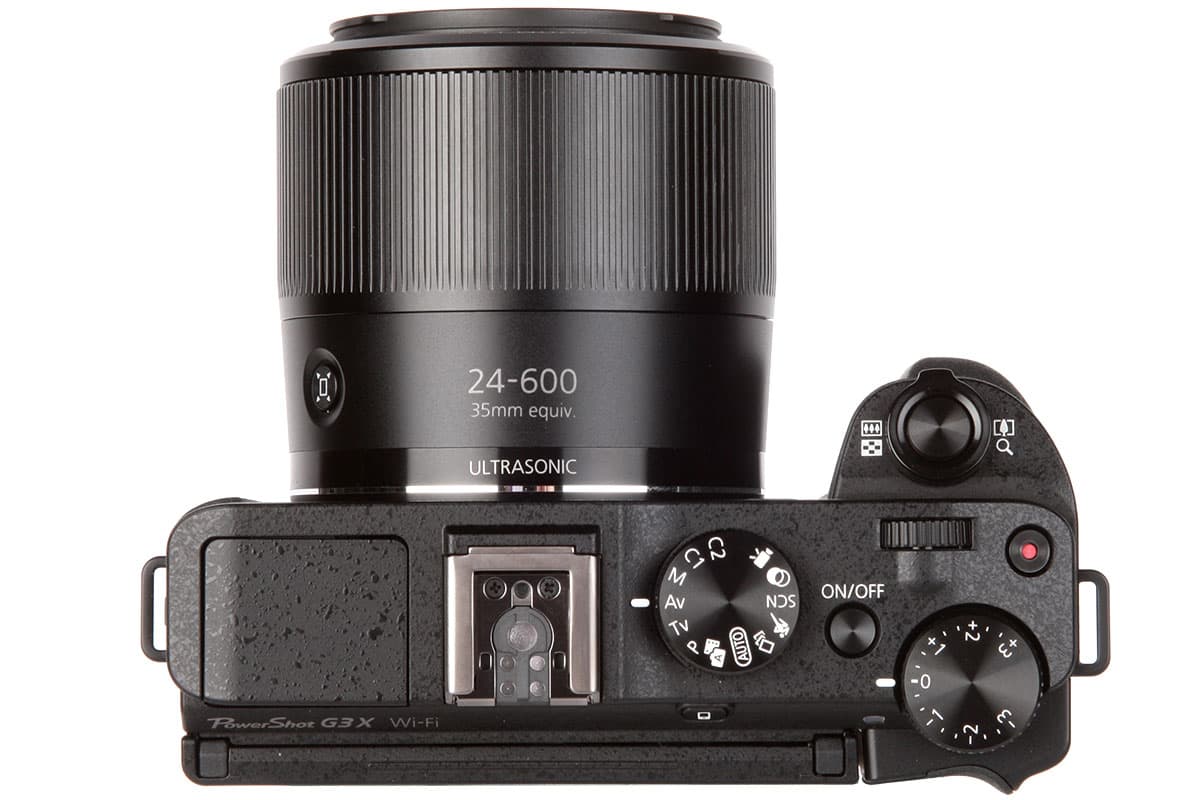
This top view shows this size of the lens barrel, even with the camera powered off
With its dustproof and splashproof magnesium-alloy body, the G3 X feels solidly made, and at 733g it’s not overly heavy, especially considering the range of the lens. The camera manages to be smaller than its shorter-zoomed competitors with 1in sensors, at 123.3×76.5×105.3mm, although this is substantially down to the omission of an EVF. In terms of design it’s little more than a box-shaped body, with a handgrip and cylindrical lens barrel added to the front.
The handgrip is covered in thick textured rubber that provides a positive hold, aided by a deep indentation for your second finger and a prominent ‘hook’ for your thumb. There’s not quite so much real estate to wrap your hand around, though, compared to the larger grips on the Panasonic FZ1000 and Sony RX10. The camera’s size and design means that your left hand naturally ends up supporting the lens barrel.
The G3 X has a decent array of controls, mostly positioned for operation by your right hand. The top-plate hosts the power and movie buttons, along with the exposure-mode dial and front electronic dial. The exposure compensation dial is perfectly placed for operation by your thumb, and offers up to 3EV correction in 1/3EV steps, which can also be used in conjunction with auto ISO in manual-exposure mode. A two-speed zoom lever around the shutter button allows reasonably precise composition.
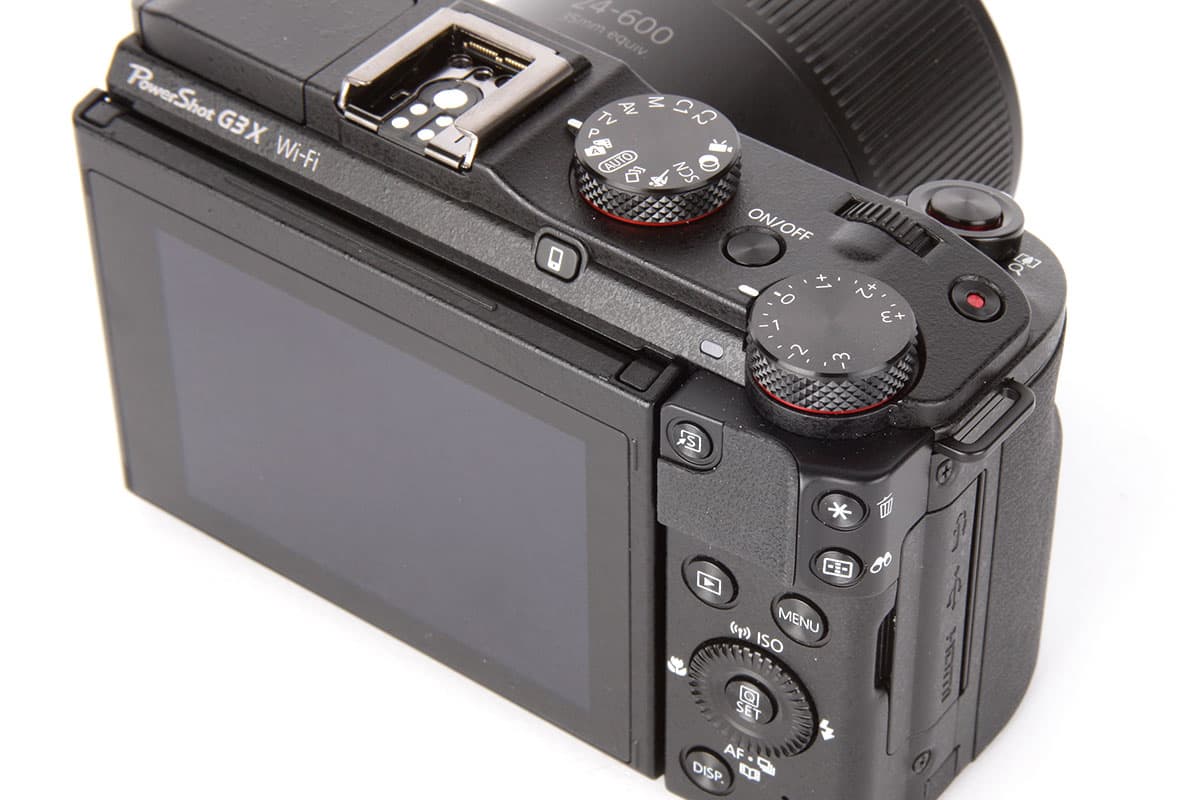
The top-plate and rear controls are positioned for use by your right hand
Canon has squeezed plenty of buttons onto the back of the camera, but because the screen takes up so much space they feel rather cramped together.
While the button placement is similar to several other small Canons, including the PowerShot G1 X II and the EOS M3, there’s no consistency in function assignment between these models, so shooting them side by side could be a recipe for confusion.
The rear electronic dial is customisable to operate a range of functions, and I set it to change ISO directly. There’s also a small customisable shortcut button placed under your thumb. The touchscreen provides a quick and responsive interface for changing settings and playing back images, but it’s less useful than most for setting the focus point during normal shooting, simply because the G3 X’s design means you don’t have a hand free to operate it.
The lens barrel has a large, smoothly rotating focus ring, which can be re-assigned to change shutter speed, aperture or ISO. Oddly, though, unlike on the Sony RX10 or Panasonic FZ1000, it can’t be used as a zoom controller.
A button on the side of the barrel engages manual focus, while a second operates Canon’s framing assist function. This is extremely useful if you lose your subject when shooting at telephoto, as pressing it temporarily zooms the lens out to show a much wider view, so you can reacquire your subject and then release it to zoom in again. Given the size of the lens barrel, though, it would have been nice to see a second control ring, as on the G1 X Mark II.
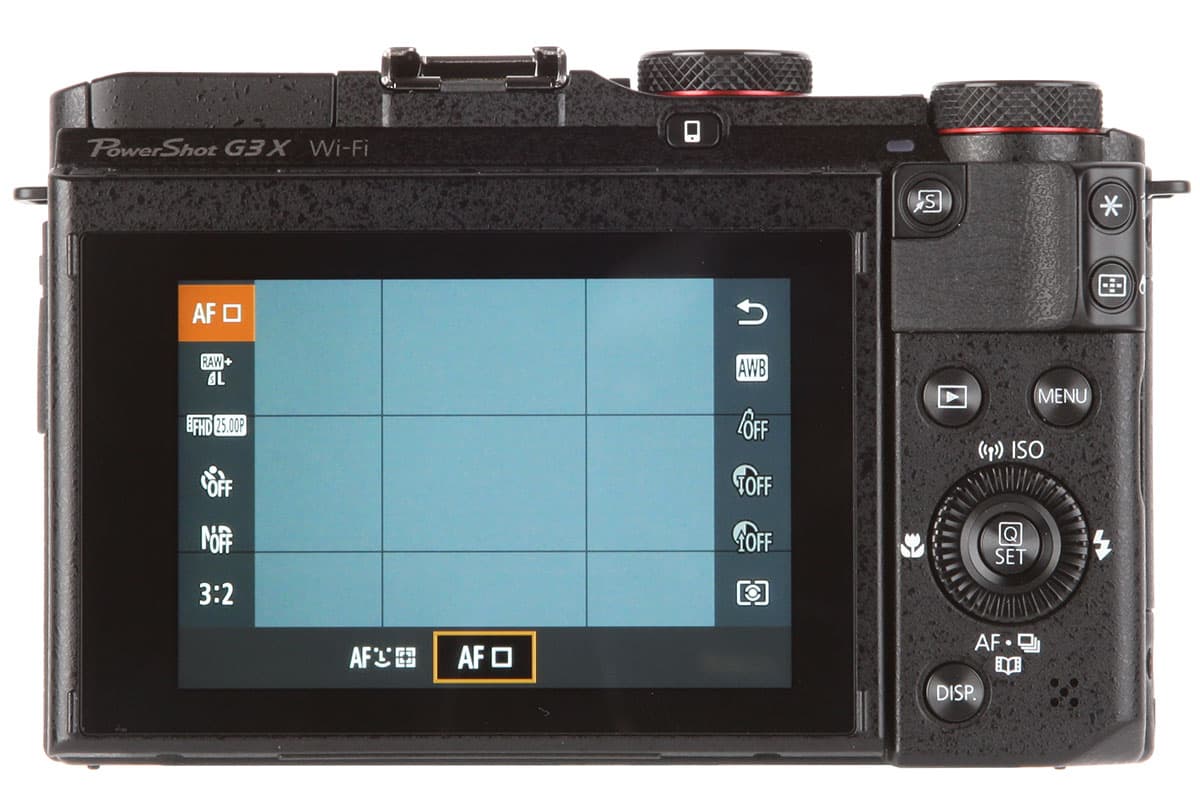
The onscreen Q menu give quick access to settings, and can be changed using the d-pad or by the touchscreen
Canon has tweaked the on-screen interface on its PowerShot compacts to more closely resemble that used on its DSLRs, but the changes are purely cosmetic. The menu items and ordering are still rather different, with similar functions given different names. For example, the G3 X has ‘DR correction’ in place of ‘highlight tone priority’, and ‘shadow correct’ rather than ‘auto lighting optimiser’, which could leave EOS users scratching their heads. Other manufacturers have done a much better job of unifying their interfaces between compact and interchangeable-lens cameras.
Unfortunately, I found that the G3 X wasn’t especially easy or pleasant to shoot with using the LCD. In particular, the 600mm equivalent zoom is predictably difficult to use with the rear screen, as it’s hard to hold the camera sufficiently steady to aim it properly and it’s more or less impossible to pan the camera to follow a moving subject. This is especially true when you’re shooting in portrait format and can’t tilt the screen to allow a more stable shooting stance. However, when shooting with the optional EVF-DC1 viewfinder, it’s much easier to use the long telephoto settings. This makes the omission of a built-in EVF all the more baffling.
Canon PowerShot G3 X review – Autofocus
In good light, the G3 X focuses quickly, decisively and accurately, just as we’d expect to see from a modern contrast-detection system. As light levels fall, though, the autofocus becomes progressively slower, especially at longer focal lengths with their slow maximum apertures, taking up to a second to acquire focus in just moderately low light. This means that the G3 X isn’t necessarily a great choice for shooting indoors in poorly lit interiors.
Continuous focusing isn’t particularly great, either. With no phase-detection elements to help it out, the G3 X is no match for either DSLRs or recent CSCs. This negates some – although not all – of the advantage of having such a long lens in a relatively small package. For example, shooting at an airshow I got relatively few shots in really sharp focus. Of course, you can always revert to manual focus in some situations, aided by a peaking display and magnified view. But again, the slow maximum aperture of the lens means that the live-view feed gets rather noisy in only moderately low light.
Canon PowerShot G3 X review – Performance

With its large sensor and effective image stabilisation. the G3 X gives good image quality in relatively low light. This was shot at 600mm equivalent and 1/320sec f/5.6 ISO 1000.
With such a long zoom, the G3 X looks ideal for subjects such as sports and wildlife where continuous shooting is commonly used, and its headline 6fps shooting speed seems great for the task. Unfortunately, there are a couple of serious caveats.
First, if you want autofocus and exposure adjusting between each frame, the shooting speed drops to 3.3fps, with the camera displaying a strangely low-resolution, out-of-focus-looking preview between frames that’s particularly disconcerting when you use the EVF.
Second, you only get this sort of speed shooting JPEG only – the moment you turn on raw, the camera slows to a crawl, shooting at a miserly 0.6fps, and blanking out the screen and viewfinder between shots. This is inexcusable for a camera costing £800 in 2015.
On a more positive note, the camera’s metering and white balance systems work very well. I rarely found myself having to adjust exposure compensation to any great extent, or switch white balance away from auto. The optical stabilisation of the lens also does a very good job of combating image blur from camera shake, although it visibly struggles to deal with camera movement when shooting at full telephoto using the LCD.

Switching the G3 X to anything but the default JPEG processing, such as black and white mode, disables raw capture
In terms of image quality, the 1in sensor behaves much as we’ve come to expect, combining impressive detail at low resolution with relatively low noise at higher sensitivity settings. Not surprisingly for a 25x zoom, the lens is a little compromised, although in truth rather less than I’d expect.
At the wide end of the range the centre of the frame tends to be very sharp, but the corners are visibly soft at the pixel level. Given that you’ve got 20.2 million pixels to play with, this is only likely to show up on prints larger than 12x8in.
The lens actually gives the most even results across the frame at telephoto settings, although at the maximum aperture of f/5.6 image there’s some slight image softening due to diffraction, so images are never quite as crisp as those you get from cameras with faster, shorter zoom lenses like Canon’s own PowerShot G7 X.
Canon’s default JPEG processing gives bright, saturated colours with rich blue skies, but these could be a little overblown for some tastes. Noise reduction is also quite aggressive, blurring away fine detail even at moderate ISO settings. You can tone down colours using the ‘My Colors’ option in the Q Menu, but oddly, not if you’re also shooting raw, as the menu option is then disabled. So if you want to shoot raw+JPEG, with the intention of using JPEGs by default and processing only your favourite shots from raw, you’re stuck with Canon’s somewhat unsubtle processing.
Canon PowerShot G3 X review – Test results
In general, the Canon PowerShot G3 X offers similar image quality to other premium compacts that use the same 20.2-million-pixel, BSI CMOS sensor, and is therefore vastly superior to superzoom cameras with small 1/2.3in sensors such as the PowerShot SX60 HS. It is capable of recording lots of detail at low ISO settings, while giving reasonably low-noise images up to about ISO 800. Beyond this it gets increasingly stretched, and ISO 6,400 and above are barely acceptable.
With only limited software support available (only Canon’s own Digital Photo Pro supports the camera at the time of writing), we’ve not been able to look at raw image quality as far as we’d like, and spent more time looking at Canon’s JPEGs than is ideal. The images certainly bright and punchy, but I suspect many enthusiast photographers would like to tone down their excesses a little. Unfortunately, Canon doesn’t allow you to modify the JPEG processing if you also want to record raw files.
Resolution
At its best around the 50mm equivalent mark on the lens, the G3 X is capable of resolving close to 3,200l/ph at ISO 125, which is as good as anything else we’ve seen with this sensor. With our high-contrast black & white resolution test chart, this drops only slightly as the ISO is raised, to about 2,800l/ph at ISO 1600. But beyond this the resolution drops off more rapidly as noise increases, with the top two settings giving poor results.

Canon PowerShot G3 X resolution, ISO 125

Canon PowerShot G3 X resolution, ISO 125
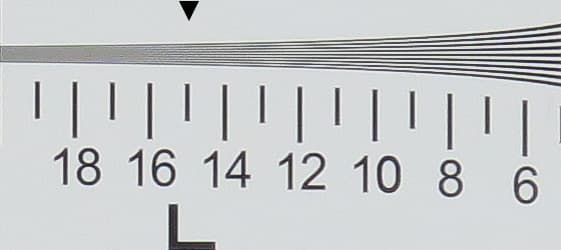
Canon PowerShot G3 X resolution, ISO 400
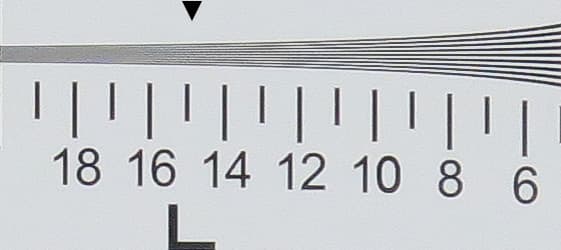
Canon PowerShot G3 X resolution, ISO 800
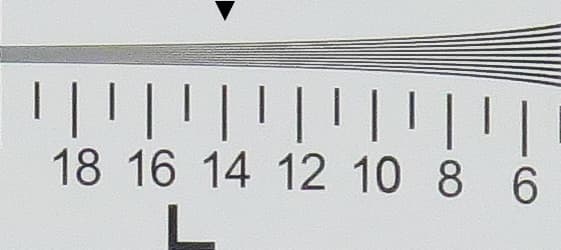
Canon PowerShot G3 X resolution, ISO 1600

Canon PowerShot G3 X resolution, ISO 3200

Canon PowerShot G3 X resolution, ISO 6400

Canon PowerShot G3 X resolution, ISO 12800
Canon PowerShot G3 X review – Dynamic range
The G3 X’s 20.2MP sensor delivers good results at low ISO sensitivities in our Applied Imaging tests, with nearly 12EV of dynamic range at ISO 125. In practice, this means that it doesn’t clip highlights as abruptly as cameras with smaller sensors tend to, while also retaining a bit more useful shadow detail. But at ISO 800 and above it falls off quite quickly, reflecting increasing noise levels particularly in the shadows. The top three ISO settings give particularly low readings.

Canon PowerShot G3 X dynamic range
Noise and detail
At ISO 125 the G3 X gives impressively detailed images, with barely any visible noise. A hint of luminance noise appears at ISO 400 when examining images on the pixel level, but this will have no serious impact on prints. At ISO 800 the impact becomes a little more severe, with fine low-contrast detail beginning to smear away, and at ISO 1,600 this is accentuated, with shadow detail becoming lost too. At ISO 3,200 the effects of noise and noise reduction are quite obvious, making it best avoided if possible, while ISO 6,400 and ISO 12,800 should only be used if there’s really no other choice.
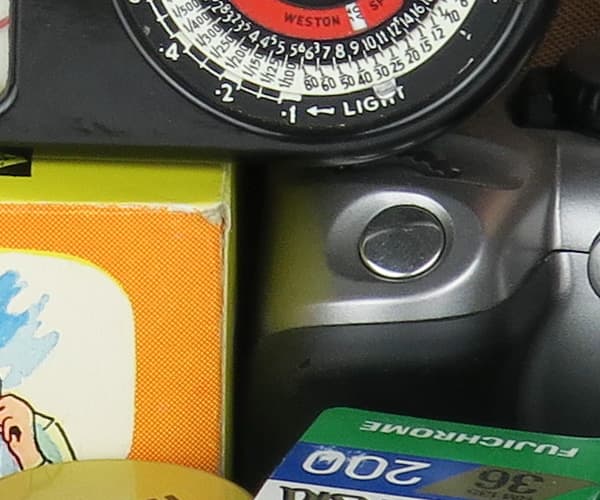
Canon PowerShot G3 X ISO 125
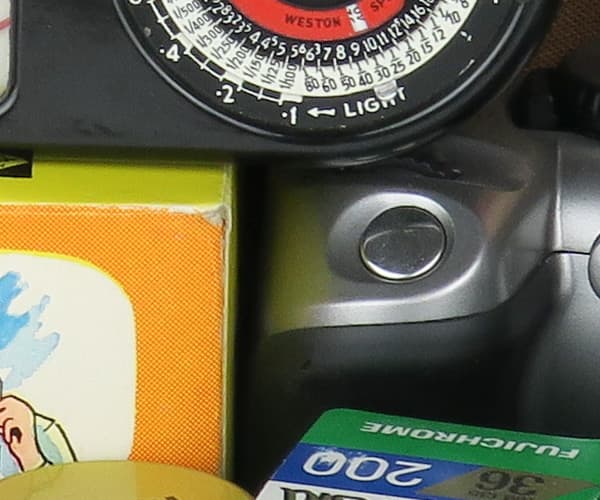
Canon PowerShot G3 X ISO 200
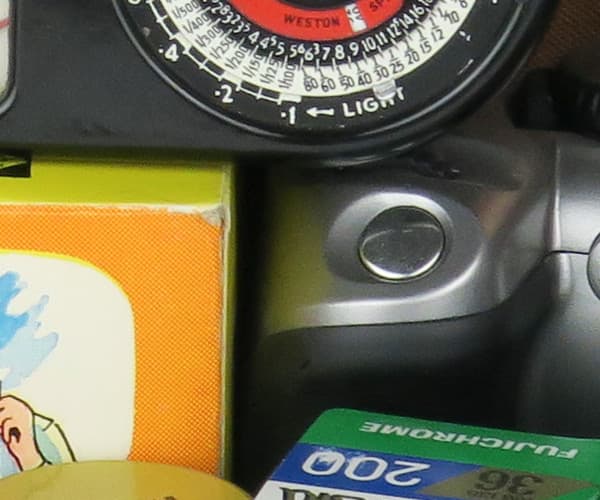
Canon PowerShot G3 X ISO 400
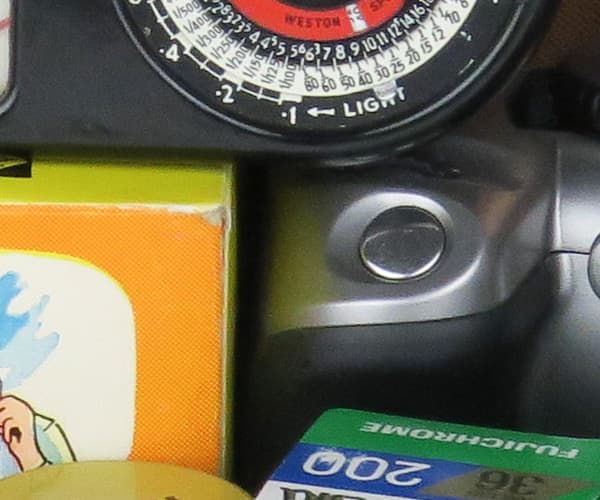
Canon PowerShot G3 X ISO 800
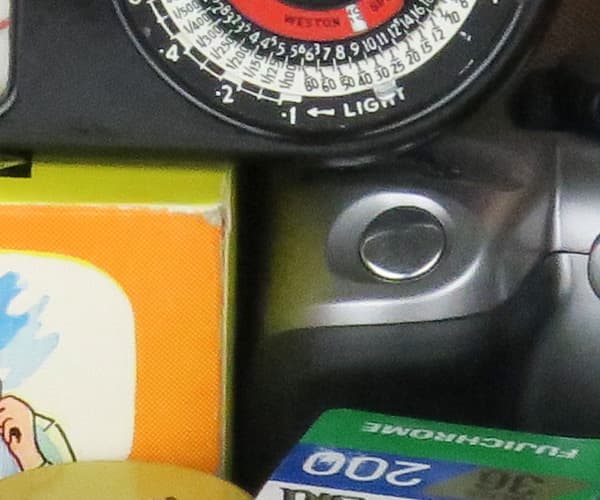
Canon PowerShot G3 X ISO 1600
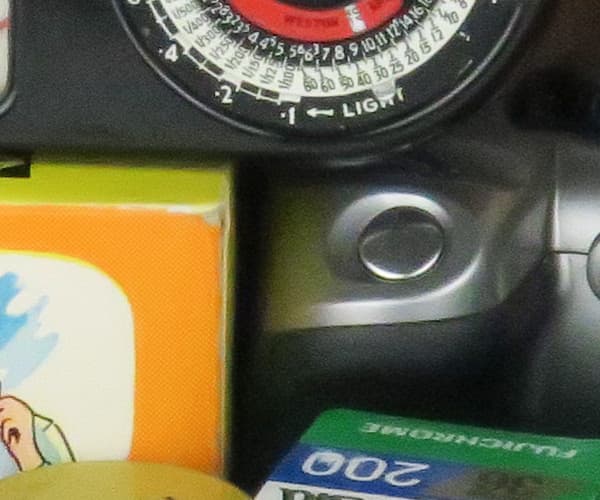
Canon PowerShot G3 X ISO 3200

Canon PowerShot G3 X ISO 6400
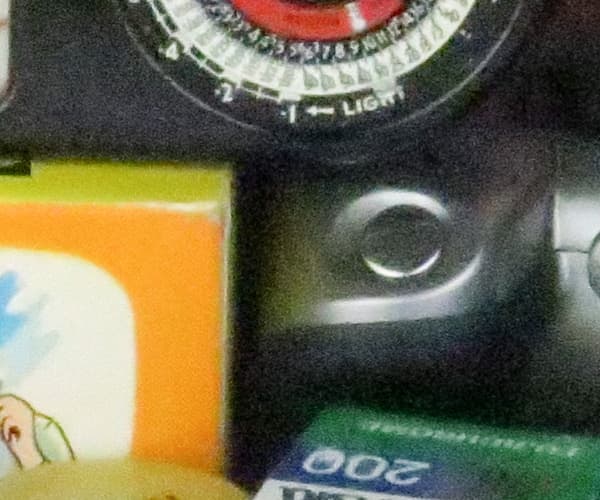
Canon PowerShot G3 X ISO 12800
This is all familiar behaviour from this sensor, but it’s worth pointing out that the G3 X’s slow maximum aperture forces you to raise the ISO sooner as light levels drop, especially when shooting at the long end of the zoom where you’ll need faster shutter speeds to avoid blurred images from subject movement and camera shake.
Canon PowerShot G3 X review – Verdict
When Canon first told us it was making a camera with a 1in sensor and 600mm equivalent zoom, it looked really exciting. Sadly, though, the G3 X manages to be rather less than the sum of its parts. The lack of a built-in viewfinder makes using that long lens effectively something of a trial, and while adding the EVF-DC1 viewfinder fixes this problem, it makes the camera unnecessarily bulky and takes the price to almost £1,000. The relatively slow lens also negates much of the high ISO advantage afforded by the larger sensor.
However, the real problem for the G3 X is the competition, in the shape of the incredibly accomplished Panasonic FZ1000 and Sony RX10. Both offer built-in viewfinders and superior ergonomics, meaning that the G3 X’s longer lens becomes its main selling point in comparison. It falls short in supporting the typical photographic opportunities afforded by that extra zoom, with poor continuous shooting behaviour and – again – no viewfinder. Granted, it’s smaller than either of those cameras, but not to a degree that really matters in practical terms.
This is a shame, because if Canon had simply followed the established design template for long zoom cameras, the G3 X could have been really exciting. Instead, it feels too compromised in too many areas, and doesn’t excel in any one area to really recommend it. Ultimately, for almost any purpose, you can get another camera that will do the job better at a lower price.





